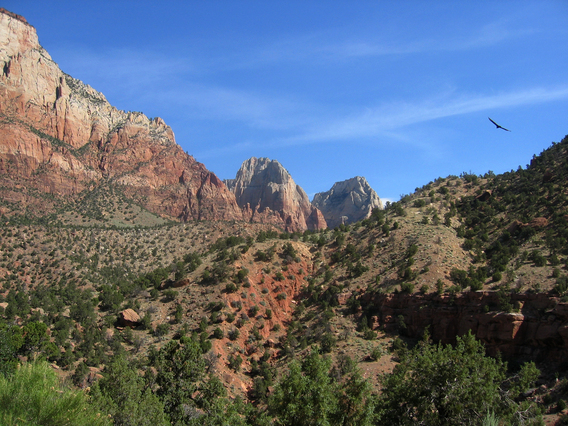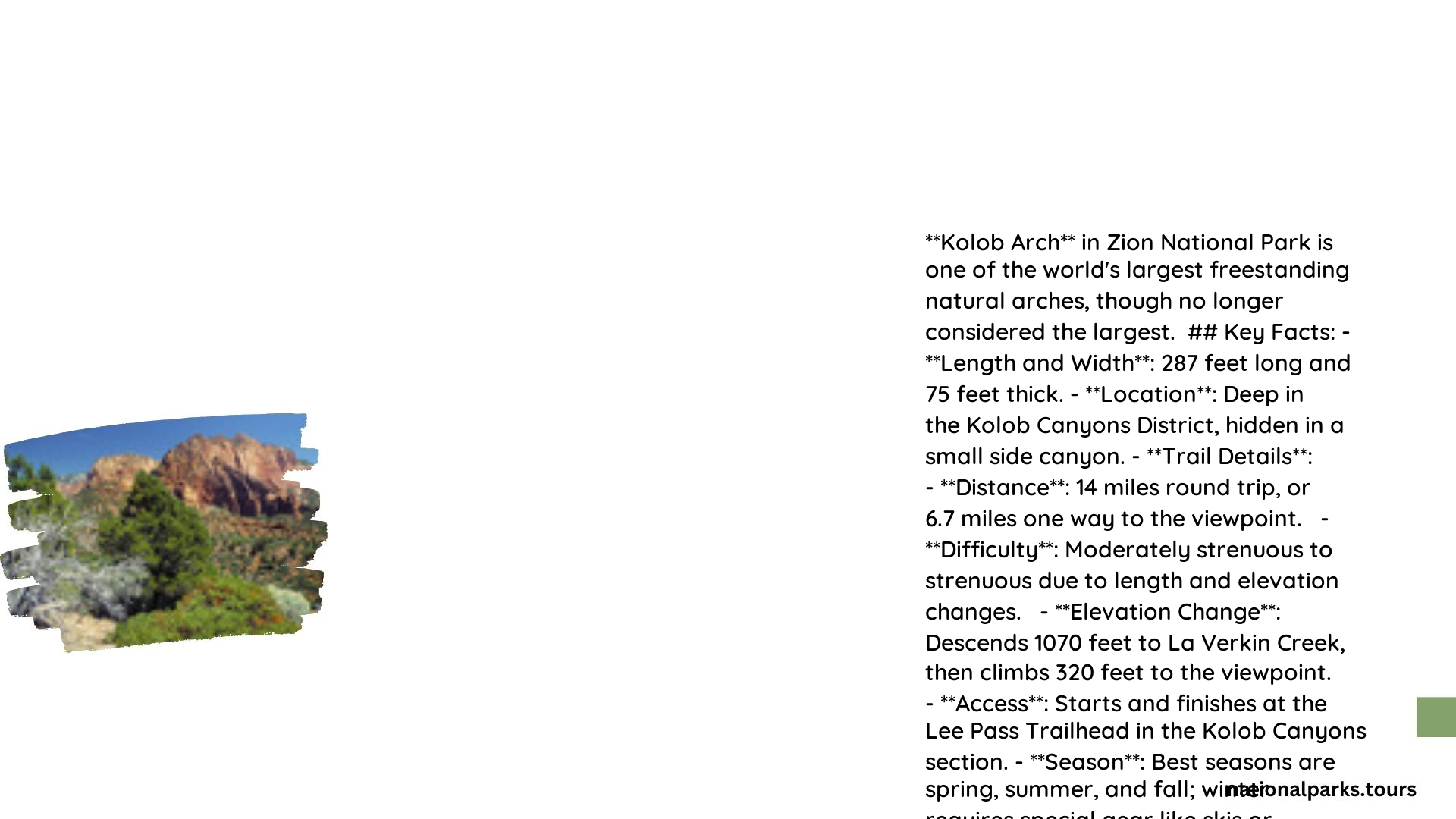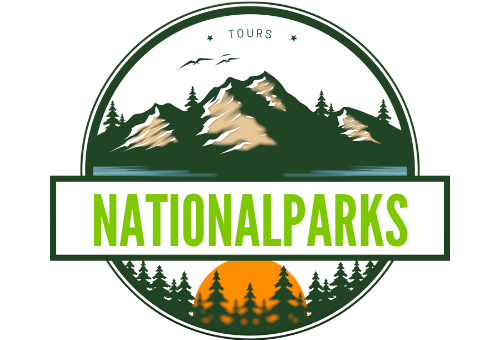Zion Kolob Arch, located in the remote Kolob Canyons section of Zion National Park, is a natural marvel that beckons adventurous hikers. This impressive sandstone formation, spanning 287 feet, is one of the world’s largest known natural arches. The journey to Zion Kolob Arch offers a challenging yet rewarding experience, traversing through diverse landscapes of red rock canyons, lush vegetation, and pristine wilderness. This hidden gem provides a unique opportunity to explore a less-visited area of Zion, offering solitude and breathtaking views that rival the park’s more famous attractions.
What Makes Zion Kolob Arch Unique?

Zion Kolob Arch stands out for several reasons:
- Size: At 287 feet, it’s one of the largest natural arches in the world.
- Location: Situated in the less-crowded Kolob Canyons area of Zion National Park.
- Scenic Beauty: Surrounded by stunning red rock formations and diverse flora.
- Challenging Access: The strenuous hike adds to its allure for adventure seekers.
- Photographic Opportunities: Offers unique angles for landscape photography.
How Do You Reach Zion Kolob Arch?

To reach Zion Kolob Arch, follow these steps:
- Drive to the Kolob Canyons section of Zion National Park.
- Locate the Lee Pass trailhead (GPS coordinates: 37.452101, -113.191382).
- Begin the 14-mile round-trip hike on the La Verkin Creek Trail.
- Follow the trail for about 6.5 miles to reach the Kolob Arch spur trail.
- Take the spur trail for an additional 0.5 miles to reach the arch viewpoint.
What Are the Trail Specifics for Zion Kolob Arch?
The trail to Zion Kolob Arch has the following characteristics:
- Distance: 14 miles round-trip
- Elevation Gain: Approximately 1,700 feet
- Difficulty: Strenuous
- Trail Type: Out and back
- Estimated Time: 7-10 hours for experienced hikers
| Trail Feature | Description |
|---|---|
| Terrain | Single-track path with steep sections and loose footing |
| Water Crossings | Several stream crossings along the route |
| Sandy Sections | Some areas require hiking through sand |
| Shade | Limited shade, especially in summer months |
When Is the Best Time to Visit Zion Kolob Arch?
The optimal times to visit Zion Kolob Arch are:
- Spring (March-May): Mild temperatures and potential wildflower blooms
- Fall (September-November): Cooler weather and vibrant autumn colors
- Early Summer (June): Warm but not excessively hot, with longer daylight hours
Avoid:
– Late Summer (July-August): Extreme heat and potential for thunderstorms
– Winter (December-February): Cold temperatures and potential snow/ice on trails
What Should You Pack for the Zion Kolob Arch Hike?
Essential items for your Zion Kolob Arch hike include:
- Plenty of water (at least 3-4 liters per person)
- High-energy snacks and lunch
- Sun protection (hat, sunscreen, sunglasses)
- Sturdy hiking boots
- Trekking poles (optional but recommended)
- First aid kit
- Navigation tools (map, compass, or GPS device)
- Camera for capturing the stunning views
Are There Any Permit Requirements for Zion Kolob Arch?
Permit requirements for Zion Kolob Arch are as follows:
- Day Hikes: No permit required
- Overnight Trips: Wilderness Permit required
- Can be reserved online at recreation.gov
- Available in-person at Zion visitor centers
- Group Size Limits: Maximum of 12 people per group
What Photography Tips Can Enhance Your Zion Kolob Arch Experience?
To capture the best photos of Zion Kolob Arch:
- Visit during early morning or late afternoon for optimal lighting.
- Use a wide-angle lens to capture the arch and surrounding landscape.
- Experiment with different compositions, including framing the arch with nearby trees or rock formations.
- Consider long-exposure shots of La Verkin Creek for added interest.
- Bring a tripod for stability, especially in low-light conditions.
How Does Zion Kolob Arch Compare to Other Arches in the Region?
Zion Kolob Arch stands out among other regional arches:
| Feature | Zion Kolob Arch | Landscape Arch (Arches NP) | Kolob Arch (Zion NP) |
|---|---|---|---|
| Length | 287 feet | 290 feet | 287 feet |
| Accessibility | Strenuous 14-mile hike | Easy 1.6-mile hike | Strenuous 14-mile hike |
| Crowd Levels | Low | High | Low |
| Scenic Setting | Remote canyon | Desert landscape | Remote canyon |
What Wildlife Might You Encounter on the Zion Kolob Arch Trail?
The diverse ecosystem around Zion Kolob Arch supports various wildlife:
- Mule Deer
- Desert Bighorn Sheep
- Mountain Lions (rare sightings)
- Various Bird Species:
- Golden Eagles
- Peregrine Falcons
- Canyon Wrens
- Reptiles:
- Lizards
- Non-venomous Snakes
Remember to observe wildlife from a safe distance and never feed or approach animals.
How Can You Practice Leave No Trace Principles at Zion Kolob Arch?
To preserve the natural beauty of Zion Kolob Arch:
- Pack out all trash, including biodegradable items.
- Stay on designated trails to prevent erosion.
- Use established campsites if backpacking.
- Properly dispose of human waste (use WAG bags or bury 6-8 inches deep, 200 feet from water sources).
- Leave natural objects and cultural artifacts undisturbed.
- Minimize campfire impacts by using established fire rings or camp stoves.
- Respect wildlife by observing from a distance.
By following these principles, you help protect this magnificent natural wonder for future generations to enjoy.
References:
1. Kolob Arch via Lee Pass Trailhead – Hike St George
2. Kolob Canyons Wilderness Hiking Trails – National Park Service
3. Zion National Park Kolob Arch & Fingers Road | Strenuous – Visit Utah
